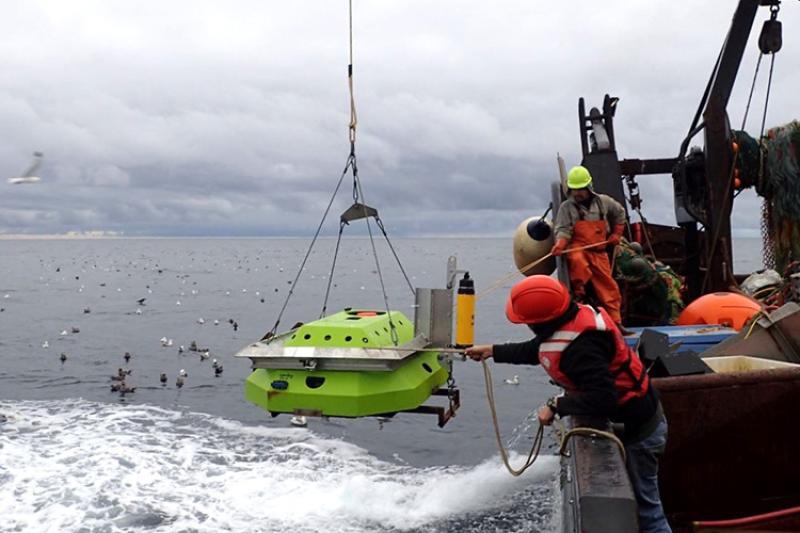
New evidence of seasonal and temperature-driven movement of Alaska Pollock
by NOAA Fisheries 29 Jun 2024 17:59 UTC

A mooring being deployed from a fishing vessel © NOAA Fisheries
Scientists use innovative technology to track northwest migrations in the late spring and early summer and southeast migrations in the winter. Migrations appear to be driven by water temperature.
Scientists placed specially designed moorings, equipped with sonar, on the seafloor to acoustically monitor pollock abundance and movements between U.S. and Russian waters. They found that a substantial amount of pollock travel between the two exclusive economic zones (EEZs) seasonally.
The study was conducted from summer 2019 to summer 2020. During this time, pollock moved southeast over the maritime boundary in winter as the sea ice formed. They were largely absent in late spring when ocean temperatures were near freezing and the sea ice was still present. They subsequently migrated northwest in late spring and early summer as waters warmed. The extent of the movement between EEZs) appears to be partially driven by water temperature.
When the moorings were deployed in summer 2019 the area was unusually warm. Following the winter migration into U.S. waters, conditions were cooler in summer 2020. Over the year of observations, 2.3 times more pollock moved into the U.S. EEZ in fall and winter then exited during the subsequent spring and summer. Scientists believe the cooler conditions in 2020 led to fewer pollock moving into Russian waters than had the previous year.
"There are some important implications for pollock management," said Robert Levine, physical scientist and lead author on a new paper published in the ICES Journal of Marine Science. "Our research suggests that in years when water temperatures are warmer than average, the proportion of fish moving across the boundary will be greater."
Scientists suspect that continued warming in the eastern Bering Sea will increase the proportion of the pollock stock found in Russian waters. Currently, pollock support the top U.S. commercial fishery, which harvests more than 1 million metric tons annually.
Moorings Provide Year-Round Data, Complement Seasonal Ship-Based Surveys
Scientists conducted the study from July 2019 to August 2020 at the end of a multi-year period of record marine heatwaves in the Bering Sea. They deployed a modified version of sonar technology used on survey vessels on the seafloor.
Survey vessels capture a snapshot in time, These "upward-looking echosounders" are able to quantify the directional movements of fish over extended periods. They also have the potential to help us better understand how climate variability will affect these migrations.
In this study, the scientific team deployed echosounders on the seafloor at four sites along the U.S.-Russia Convention Line in the Bering Sea. The devices recorded the passage of fish above them for just over a year. The echosounders were also equipped with sensors to collect physical oceanographic data, which is linked to fish migratory behavior.
So how do they work? The echosounders emit an acoustic signal—a ping—that echoes off the fish. Based on the strength of the echo, scientists estimate the number of fish in the water. They measure fish movements by tracking individuals as they move through the sonar beam in successive pings. These underwater devices cannot transmit data in real time, so they store the data until the devices can be retrieved.
Alaska pollock are the most abundant fish species in the Bering Sea, comprising 60 percent of the total biomass. Acoustic-only observations like the data collected by the moorings have been used to measure pollock abundance. They are used to inform fisheries management.
"Transboundary movements of fish stocks are a key source of uncertainty for management, but they are very difficult to measure directly. This cost-effective approach provides acoustic measurements of fish abundance and behavior over long time periods. It gives us a new view of pollock seasonal migrations that you can't get from traditional surveys." said Alex De Robertis, co-author and fish biologist at the Alaska Fisheries Science Center.
Previous Use of Sonar Technology
This is not the first time Center scientists have used upward-looking sonars to monitor pollock. In 2015, they used this unique acoustic technology to capture migrations of spawning fish in Shelikof Strait in the Gulf of Alaska. Similar moorings were also used to track the movement of age-0 fish in the Alaska Arctic from 2017-2019.
Data collected in research surveys and from observers on commercial fishing boats has supported sustainable pollock fisheries management in both the U.S. and Russia for decades. However, continued warming of the Bering Sea shelf is likely to alter pollock distributions in the future. Technology like this will help track these changes and ensure continued sustainability of this important commercial fishery and help inform our understanding of ecosystem changes in Alaska.
The scientific team also sees potential applications for this technology worldwide.
"Around the world, there are many commercially important marine species that are distributed across multiple management areas and undergo transboundary movements. It can be challenging to effectively manage these stocks due to seasonal and annual movements and distribution changes due to climate change. This approach will be most effective in situations where the marine ecosystem is dominated by a single species, like for monitoring pollock in Alaska. In cases like this you can be fairly confident that the acoustic data represent changes in abundance and behavior of the dominant species," added Levine.